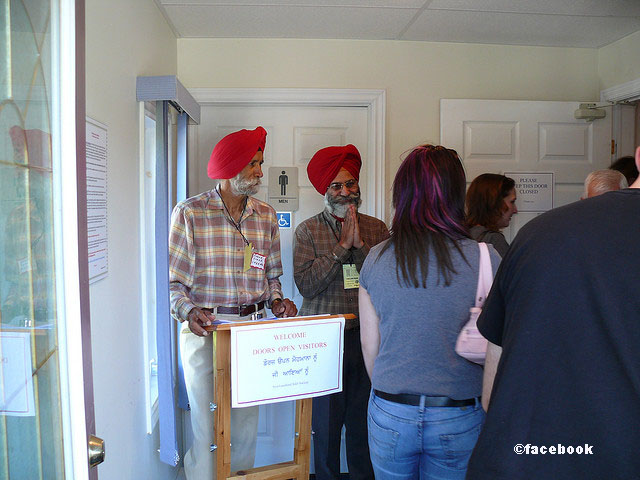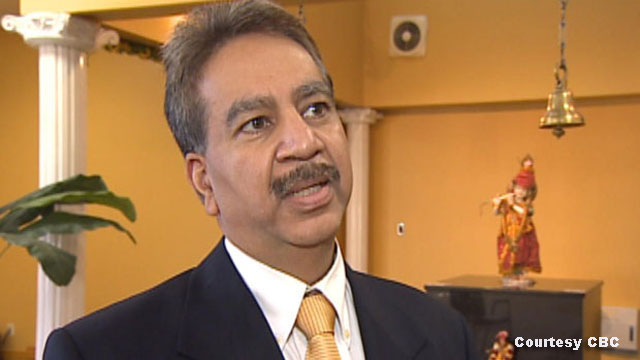By Swati Sharan
ST JOHN’S (Newfoundland): As the current Indian elections make top news on our television channels, my family members here in this eastern-most part of Canada watch with suspense who the next Indian leader will be amid all the mud-slinging.
In between all this, my parents debate whether Indian elections are being handled in a more or less civilized way than in the past. They then tune into a serial like Jodha Akbar and then watch a pre-recorded show like Comedy Nights with Kapil. Observing my parents, one would really need to stare outside the window to realize we are in windy St. John’s, Newfoundland.
Sometimes I even wonder whether some Indians here are leading ghettoized existence the way Bharati Mukherjee has chronicled in one of her novels about an Indian couple in New Jersey. In this set-up, they are carrying out their daily activities in the Indian way by not even speaking in English.
Upon some introspection, I conclude that we haven’t quite come to that point because we don’t have the Indian shops or employers required to carry out such a lifestyle. (We still have to order the bulk of our groceries from Toronto though we do get some odd items from the local grocery stores). But perhaps we live in our so-called current bubble because we feel starved for more drama than what Kevin O’Leary as the Mallika Sherawat of CBC can offer on Dragon’s Den.
Jokes aside though, it is safe to conclude that St. John’s has come a long way since the 1960s when even to make yogurt, buttermilk needed to be ordered from Halifax.
The earliest settlement of Indians in Newfoundland that I am aware of is of a Marathi couple that stayed here around 1955. The husband was asked to teach about Gandhian principles for the history department at Memorial University of Newfoundland (M.U.N.) He spent about three months working here in Newfoundland before he moved out. I later met this couple several years later in Vancouver in 2001. Unfortunately, I can’t remember their last names because I only spoke with them briefly at a conference.
FRIENDS OF INDIA
Our elders in the community say a stable Indian population started forming here in the 1960s which led to the formation of the Friends of India in 1966. However, no organized body of knowledge really exists about the settlement of Indians here. But with Canada Post releasing the Komagata Maru, it is really becoming a point to ponder. Because whereas for the western side of Canada, we will also get a Deepa Mehta film with Akshay Kumar starring in it, we can’t say the same about our eastern side.
Mind you even if we did have a film made about us, it likely wouldn’t be so translatable to the screen because how long could people go on watching a bunch of professors quietly researching on their desks? So I am therefore not going to suggest that making a film on us is warranted but a basic history on a website shouldn’t be out of the question.
It’s further a shame if we don’t do something about this because our history here is also not as old. I am also, by the way, further inspired by our Chinese community here who have made all kinds of effort to preserve their history in Newfoundland by having their exhibit at Memorial University of Newfoundland’s Queen Elizabeth Library with pictures and artifacts.
But perhaps what has been a limitation in our preserving abilities has been that quite a number of Indians that settled here during different points in time lived here only temporarily and then shifted off somewhere else. Now this likely owes to the fact that Newfoundland was not an industrialized province and most of the Indians that were coming here have either come largely as professors and doctors or engineers in the oil sector. In many cases, people were getting posted in rural areas for limited periods. Or some may have found it harder to adjust to living in smaller rural places. And what has further complicated this is that either some of the elder generation have passed on or quite a number of them have moved away to be near their children.
[caption id="attachment_85736" align="alignnone" width="640"] When the Sikh temple opened in St John’s in 2007.[/caption]
The Komagata Maru stamp release has inspired me to do is make greater efforts to seek out what I can about South Asian heritage in Newfoundland through this series. Now while by God’s grace, none of us faced the hardships of the earlier Indian settlers in this country, it is important that we collect the information that we can. Maybe we’re not going to have street signs in Punjabi like there are in Vancouver in the Indian part of town but it doesn’t mean that we’re not contributory to city living.
CONTRIBUTION OF INDO-CANADIAN HOUSEWIVES
Even with such a small population of South Asians, no matter the age group, some have accomplished excellence in their fields. While some have topped math competitions as youngsters in primary school, some others have made it on the dean’s list in the university. And while doing this is not possible for the average person, there are common areas of life that have permeated into change.
Some of this includes being visible in multi-faith symposiums or having open houses for different places of worship. Or it could mean something as simple as people asking us for recipes for aloo tikki or asking the Sanskrit meaning of a Yoga pose. In fact, one of the Indo-Canadian community’s most visible contributions to the city’s lifestyle has come from many of the housewives of my mother’s generation. But few probably realize it.
About 27 years ago, a small Hindu temple fundraising booth to sell samosas was started by some housewives along the sides of the Quidi Vidi Lake during what is known as the annual Regatta. The annual Regatta is a series of boat races with a big outdoor fair lined around the lake that takes place during the first Wednesday of every August.
Hindu temple president Anil Raheja.
[caption id="attachment_85737" align="alignnone" width="640"]
When the Sikh temple opened in St John’s in 2007.[/caption]
The Komagata Maru stamp release has inspired me to do is make greater efforts to seek out what I can about South Asian heritage in Newfoundland through this series. Now while by God’s grace, none of us faced the hardships of the earlier Indian settlers in this country, it is important that we collect the information that we can. Maybe we’re not going to have street signs in Punjabi like there are in Vancouver in the Indian part of town but it doesn’t mean that we’re not contributory to city living.
CONTRIBUTION OF INDO-CANADIAN HOUSEWIVES
Even with such a small population of South Asians, no matter the age group, some have accomplished excellence in their fields. While some have topped math competitions as youngsters in primary school, some others have made it on the dean’s list in the university. And while doing this is not possible for the average person, there are common areas of life that have permeated into change.
Some of this includes being visible in multi-faith symposiums or having open houses for different places of worship. Or it could mean something as simple as people asking us for recipes for aloo tikki or asking the Sanskrit meaning of a Yoga pose. In fact, one of the Indo-Canadian community’s most visible contributions to the city’s lifestyle has come from many of the housewives of my mother’s generation. But few probably realize it.
About 27 years ago, a small Hindu temple fundraising booth to sell samosas was started by some housewives along the sides of the Quidi Vidi Lake during what is known as the annual Regatta. The annual Regatta is a series of boat races with a big outdoor fair lined around the lake that takes place during the first Wednesday of every August.
Hindu temple president Anil Raheja.
[caption id="attachment_85737" align="alignnone" width="640"] Hindu temple president Anil Raheja.[/caption]
So what started out as a humble attempt on the part of many housewives has grown into such a spectacular affair that today there are so many people saying that they only attend the Regatta so that they can have Indian food from the booth. And this is when St. John’s has at least 3-4 South Asian places to dine in now unlike in the earlier days. At this stage, this booth is also one of the local Hindu temple’s bigger revenue generators now. And all this is because of the unassuming efforts of a group of people whom we would never normally expect this from.
And perhaps this taking for granted phenomenon roots to something I read about in a Chetan Bhagat article in What Young India Wants. We have become fixated on admiring those with money, fame, stature or so-called excellence. Now while achieving a field of excellence may have been the reason for how many Indians migrated to Canada in the later periods, we need to look beyond. Because it’s not always the big details that contribute to history. It’s in the odd sacrifices like those of the early Indian settlers who have allowed for people like ourselves to enjoy the freedom and rights that we do today in Canada.
(Swati Sharan is an Indian journalist based in St. John’s, Newfoundland)
Hindu temple president Anil Raheja.[/caption]
So what started out as a humble attempt on the part of many housewives has grown into such a spectacular affair that today there are so many people saying that they only attend the Regatta so that they can have Indian food from the booth. And this is when St. John’s has at least 3-4 South Asian places to dine in now unlike in the earlier days. At this stage, this booth is also one of the local Hindu temple’s bigger revenue generators now. And all this is because of the unassuming efforts of a group of people whom we would never normally expect this from.
And perhaps this taking for granted phenomenon roots to something I read about in a Chetan Bhagat article in What Young India Wants. We have become fixated on admiring those with money, fame, stature or so-called excellence. Now while achieving a field of excellence may have been the reason for how many Indians migrated to Canada in the later periods, we need to look beyond. Because it’s not always the big details that contribute to history. It’s in the odd sacrifices like those of the early Indian settlers who have allowed for people like ourselves to enjoy the freedom and rights that we do today in Canada.
(Swati Sharan is an Indian journalist based in St. John’s, Newfoundland)